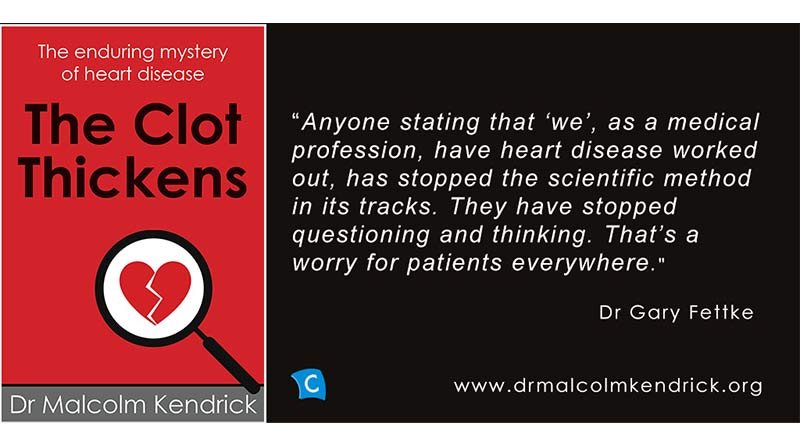The Clot Thickens

Summary
– This week’s note is about Dr Malcolm Kendrick’s new book called The Clot Thickens.
– Malcolm has been trying for 30 years to understand and explain what really causes heart disease. The diet heart hypothesis is the prevailing view. This has mutated many times over the years, but it is currently that saturated fat raises LDL-cholesterol, which causes heart disease.
– The book is structured with an introduction and two parts. The introduction sets out the diet heart hypothesis and why it is wrong. Part 1 of the book sets out the clotting hypothesis and its origins and inspirations. Part 2 covers what we can do to reduce the risk of heart disease in the context of the clotting hypothesis (and potential life expectancy gained from reducing different risks).
– There are many well known risk factors for heart disease (sex, age, smoking, sedentary behaviour etc.). Malcolm covers these and less well-known risk factors (Lupus, being on atypical antipsychotic medication, fibromyalgia, social dislocation, rheumatoid arthritis etc.)
– The diet heart hypothesis cannot explain sex and age as risk factors, let alone Lupus or being on antipsychotic medication; the clotting hypothesis can.
Introduction
Dr Malcolm Kendrick has a new book out. His first was called The Great Cholesterol Con. His second was Doctoring Data. His third was A statin nation and his latest one is called The Clot Thickens.
Declaration of interests – I am a fan and friend of Malcolm’s and we published Doctoring Data for him in 2015 and have published this latest book too. I have known Malcolm for over 10 years and all the time I have known him he’s been obsessed with what really causes heart disease. He’s been fascinated by this for nearer 30 years, so I only became aware of him in the most recent decade of his research. I admire many things about him – his intellect, his wit, his way of approaching big issues. Perhaps most of all I admire the way he attacks his own research. He will develop a hypothesis and then look to disprove it. If/when he disproves it, he considers another hypothesis – building on what he learned from the construction and destruction of the previous one. It was doing exactly this that led to the breakthrough with his new book – alongside a suggestion from a mutual friend of ours, Professor Paul Rosch, who sadly died in 2020 aged 92 after complications from a fall.
One of Malcolm’s early comments that stuck with me was (paraphrased) ‘saying that smokers are more likely to die from heart disease than non-smokers and saying that people with Lupus are more likely to die from heart disease than people without Lupus does not explain heart disease. If you cannot explain why this is the case, you have not explained heart disease.’ As Malcolm credits in The Clot Thickens, Paul was with Malcolm at a cardiovascular conference and he suggested to Malcolm that he stop looking for the cause, or even a cause, of heart disease. Paul thought that Malcolm should look for the process by which arterial damage occurred. Malcolm describes this as a lightbulb moment that changed the course of his research.
The Clot Thickens is structured as follows: the introduction goes through the diet heart hypothesis and why it is wrong. Part 1 of the book sets out the alternative hypothesis – the thrombogenic hypothesis – the clotting hypothesis. Malcolm also shares where this hypothesis has been proposed and developed by others in the past, dating back to Karl Von Rokitansky in 1852 and including one of Malcolm’s university lecturers. Part 2 of the book covers what we can do to reduce the risk of CVD – in the context of what we have just learned about the clotting hypothesis. I’ll try to give you a flavour of the book by sharing some of the themes and insights in each of those sections.
The book introduction – The diet heart hypothesis
Malcolm summarises the history of the diet heart hypothesis and how it has mutated from cholesterol in food raises cholesterol in the blood (and then causes heart disease) to fat in food raises cholesterol in the blood (and then causes heart disease) to saturated fat in food raises LDL-cholesterol (and then causes heart disease). The hypothesis has been disproven along the way (which is why it has changed), but the current view has prevailed for some years. Malcolm demolishes it.
He goes through what happens when we eat saturated fat and how LDLs (low-density lipoproteins – the carriers of cholesterol and other substances) are made by the body and how the two processes are entirely separate. It remains the case that neither Malcolm nor I can see how saturated fat raises LDL-cholesterol (or the production of low-density lipoproteins) let alone that it does.
Malcolm notes that discarding part 2 of the hypothesis (cholesterol and heart disease) took longer. Empirically all that is needed is one black swan to disprove the hypothesis that all swans are white. One such black swan for cholesterol and heart disease is the Minnesota Coronary Experiment (Ref 1). This was a large (over 9,000 participants), randomised controlled trial (the gold standard), which replaced saturated fats with polyunsaturated fats. Cholesterol levels fell in the intervention group, but this had no impact on heart disease. In fact, the greater the fall in the cholesterol level, the more people died. For each 1% fall in cholesterol there was a 1% increase in the risk of death.
I found similarly in two of my PhD papers, which reviewed not just one randomised controlled trial but all RCTs available at the time dietary guidelines were introduced (1977-1983) and at the time of my PhD examination (2012-1016) (Ref 2). Pooling all RCTs together in meta-analysis showed that cholesterol fell in the dietary intervention groups, but that this had no impact on heart disease.
Malcolm presented other evidence in this section, but he didn’t need to – one black swan is all that is needed to disprove a hypothesis. Interventions have been undertaken such that there has been a significant reduction in cholesterol but this has had no effect on heart disease (Ref 3).
In probably my favourite part of the book, Malcolm also addressed the claimed causal role of low-density lipoproteins, or the cholesterol within them, in heart disease. He stated categorically that LDL molecules cannot just enter the lining of the artery (endothelial cells) as and when they like. That’s why cells have LDL receptors – to draw the LDL into the cell where the cargo can be accessed. Malcolm has explained this further in a blog (Ref 4). Malcolm explained “if the ‘endothelium’ did not represent a perfect barrier, we would all die immediately” and he used Ebola as the example. “Ebola patients experience a breakdown in endothelial barrier integrity that leads to massive fluid losses and vascular collapse.” The endothelium must be a perfect barrier or we would be leaking fatally into any part of the body, as happens with Ebola.
The ‘but for’, therefore is that the endothelium is damaged in some way. The process of heart disease is about the ‘but for’…
The book Part 1 – The process of cardiovascular disease (CVD)
Malcolm introduces us to many important terms in this section. He holds our hand as we go through explanations of the major players in the process of CVD. Doctors will know the terms, but Malcolm is keen for the non-medical reader to understand what is important to know.
We need to cover one of the key players – Nitric oxide – here, for the rest of this section to make sense. Nitric oxide is a powerful anti-coagulant (something that prevents blood clotting). Malcolm states “I don’t think it is an exaggeration to say that nitric oxide is the single most important molecule for cardiovascular health there is. Which means anything that reduces its production will increase the risk of CVD, and vice-versa.” There are many titbits of information along the way throughout the book. E.g., did you know if you increase nitric oxide in the blood vessels of the penis, you will treat erectile dysfunction? Which is how Viagra works (Ref 5). You learn something on every page!
The ‘Readers Digest’ version of the clotting hypothesis is that blood clots and blood clotting are the key players in CVD. “The process starts when the lining of the artery wall is damaged in some way. This stimulates the formation of a blood clot (thrombus) which covers over the area, rather like a scab does when you damage your skin. A new layer of arterial lining then grows over the top of the thrombus, which effectively draws it into the artery wall. In most cases, the remnant thrombus is then fully broken down and removed. However, if there is an increased rate of damage, or bigger or tougher blood clots are formed, or the repair systems are not working so well, then repeated blood clotting at the same spot, will lead to plaques getting bigger. Eventually, they will severely narrow the artery and constrict blood flow. “
Malcolm notes that the passage above is not controversial. What is controversial is the starting point of the process. The diet heart hypothesis (current version) asserts that eating saturated fat raises LDL-cholesterol (somehow), which causes heart disease. It does this because LDL-cholesterol infiltrates the arterial wall (somehow) and causes a buildup, which blocks the artery. The clotting hypothesis asserts that anything that can damage the arterial wall can increase the risk of heart disease and anything that impairs the repair of the arterial wall can increase the risk of heart disease and anything that makes the blood ‘clotty’ can increase the risk of heart disease.
The clotting hypothesis explains why smoking (and smoky things like wood fires), lead and pollution all increase the risk of CVD – they can damage the endothelial wall, reduce nitric oxide production and increase blood clotting. Diabetes is a known risk factor for CVD. Diabetes can reduce nitric oxide synthesis, cause damage to the endothelial lining and increase blood clotting. Aging impairs the repair of the arterial wall. The condition Lupus can cause damage to the endothelial wall, but, perhaps more importantly there are many mechanisms by which Lupus can cause blood clots.
The book part 2 – What we can do to reduce the risk of CVD
This section can be concisely summarised as:
1) Avoid things that damage the endothelial wall (and vascular system generally);
2) Avoid things that impair repair of the endothelial wall (and vascular system generally);
3) Avoid things that increase blood clotting.
Having got to this part of the book, one knows what risk factors one has that can’t be changed or avoided. Age, ethnicity and genetics can’t be changed. Biological sex can’t be changed, but I found myself wondering if changing gender could reduce risk. It turns out that it increases risk – most likely because of medications and procedures undertaken to effect change. A study of 324 transgender people who had undergone gender reassignment surgery with mean follow-up of 11 years demonstrated a 2.5 times increased risk of cardiovascular death (Ref 6).
Having a serious (although thankfully rare) condition such as Lupus increases risk. Malcolm shares a number of rare conditions, many of which I had not heard of, which increase risk and support the clotting hypothesis. The final section of the book doesn’t dwell on what we can’t change – it focuses on what we can. It also quantifies modifiable risk factors in terms of estimates of increased life expectancy. We’re all going to die, so it’s not that helpful to know that something increases our risk of dying. What we want to know is – by how much? It turns out that being obese (but without diabetes) is better than being sedentary, which is better than being a smoker.
Regarding 1) above, we can do the following things to reduce the risk of damage to the endothelial wall. Don’t smoke (obviously) but also avoid smoke generally (fires etc.); eat to avoid type 2 diabetes and/or to put it into remission if you already have it; don’t take recreational drugs (cocaine etc.); avoid taking antacids if at all possible; and avoid air pollution (among other tips).
2) Things that increase nitric oxide synthesis will help to keep the endothelium healthy. Many interesting factors that help with this were presented: sunbathing; Co-enzyme Q10 (something impaired by statins, interestingly); breathing through your nose (that may be controversial currently!); certain vegetables (such as beetroot, garlic and leafy greens); red wine (Malcolm’s favourite) and dark chocolate (my favourite).
3) There are many exquisitely balanced mechanisms in the body – blood glucose, temperature, pH balance, etc. How ‘clotty’ we are is another exquisitely balanced mechanism. We need a certain ability to clot, or we would bleed to death from a paper cut. We need a certain ability to not clot, or we would have blocked arteries and die. Vitamin K is our major clot nutrient – it supports the ability to clot. This is why if we are given blood thinners (anti-clot medication) after an operation, we are often simultaneously advised to avoid foods rich in vitamin K, such as green leafy vegetables.
Malcolm covers omega-3 essential fatty acids in this section. These possess a number of different mechanisms for reducing clotting and don’t appear to have counter effects (Ref 7). Dehydration, physical stress (moving between hot and cold environments), being sedentary, acute mental stress and taking NSAIDS (non-steroidal anti-inflammatory drugs) can all increase clotting and thus should be avoided as far as possible.
In summary
Malcolm noted that “As far back as 1981, a compilation of 246 items were gathered together and published in a paper, entitled: ‘A survey of 246 suggested coronary risk factors’” (Ref 8). Malcolm tested the clotting hypothesis on well known risk factors (sex, age, smoking, sedentary behaviour etc.) and less well-known risk factors (being on atypical antipsychotic medication, fibromyalgia, social dislocation, rheumatoid arthritis etc.) and it holds.
In contrast, the saturated fat/LDL-cholesterol hypothesis explains virtually none of them. The diet heart hypothesis fails on arguably the two biggest risk factors – sex and age. The first is rapidly demonstrable – women have higher cholesterol than men and lower incidence of heart disease. The age contradiction is nicely illustrated (although this was not intended) in Webtable 3 in the supplementary appendix to the Clinical Trial Service Unit (CTSU) paper about statins in the elderly (Ref 9). The table shows that total cholesterol falls steadily from the youngest to the oldest age groups in both the top and bottom sections of the table. LDL-Cholesterol falls steadily from the youngest to the oldest age groups in both the top and bottom sections of the table. HDL-cholesterol rises steadily from the youngest to the oldest age groups in both the top and bottom sections of the table. Meanwhile, heart disease rises steadily from youngest to oldest age groups (Ref 10).
Then how does the saturated fat/LDL-cholesterol hypothesis explain wood fires or Lupus or being on atypical antipsychotic medication or rheumatoid arthritis as risk factors of heart disease? The answer is – it doesn’t.
At the front of the book, a number of people have reviewed the book and shared a comment.
The one that best summed up the book (in my view) was this one from a Swedish doctor, Dr Sebastian Rushworth:
“Malcolm Kendrick’s new book brings to mind the quote from Thomas Huxley when he first learned of Darwin’s theory of evolution: ‘how extremely stupid (of me) not to have thought of that’. What Kendrick presents is nothing less than a unifying theory of heart disease, that explains why everything from sickle cell disease to diabetes to a stressful lifestyle increases cardiovascular risk (and he does it with a large dollop of humour). After decades stuck in the blind alley that is the LDL hypothesis, this book is a revelation. It should be read by anyone with even a slight interest in understanding heart disease and what they can do to protect themselves from it.”
My review tried to sum up what I think Malcolm has achieved: “For 30 years, Dr Malcolm Kendrick has been obsessed with what really causes heart disease (spoiler alert – because it’s not cholesterol). He has built hypotheses and then knocked them down in a genuinely scientific search for the truth. A chance breakthrough led to him looking for the process by which heart disease forms and suddenly all the single causes made sense. This book describes how Dr Kendrick established the explanation that withstands scrutiny and what it is. Having read so much of his work over so many years, I think he’s got there. I really think he has.”
References
Ref 1: Ramsden et al. Re-evaluation of the traditional diet-heart hypothesis: analysis of recovered data from Minnesota Coronary Experiment (1968-73). BMJ. 2016.
Ref 2: Harcombe Z et al. Evidence from randomised controlled trials does not support current dietary fat guidelines: a systematic review and meta-analysis. Open Heart 2016.
Harcombe Z et al. Evidence from randomised controlled trials did not support the introduction of dietary fat guidelines in 1977 and 1983: a systematic review and meta-analysis. Open Heart 2015.
Ref 3: This simultaneously supports the hypothesis that statins have other effects. That the mechanism by which any benefit is delivered is not via cholesterol lowering.
Ref 4: https://drmalcolmkendrick.org/2021/11/04/the-enduring-mystery-of-heart-disease-the-clot-thickens/
Ref 5: VIAGRA®Clinical Pharmacology (sildenafil citrate). Pfizer. https://www.pfizermedicalinformation.com/en-us/viagra/clinical-pharmacology
Ref 6: Connelly et al. Gender-Affirming Hormone Therapy, Vascular Health and Cardiovascular Disease in Transgender Adults. Hypertension. 2019.
https://www.ahajournals.org/doi/10.1161/HYPERTENSIONAHA.119.13080
Ref 7: Wachira et al. n-3 Fatty acids affect haemostasis but do not increase the risk of bleeding: clinical observations and mechanistic insights. Br J Nutr. 2014. https://pubmed.ncbi.nlm.nih.gov/24472372/
Ref 8: Hopkins & Williams. A survey of 246 suggested coronary risk factors. Atherosclerosis. 1981. https://www.atherosclerosis-journal.com/article/0021-9150(81)90122-2/pdf
Ref 9: https://www.thelancet.com/cms/10.1016/S0140-6736(18)31942-1/attachment/da6878a9-732e-4952-99f7-a716706964ae/mmc1.pdf
Ref 10: Set out in a post (closed view) here https://www.dietandhealthtoday.com/2019/02/why-cholesterol-cant-cause-heart-disease/


